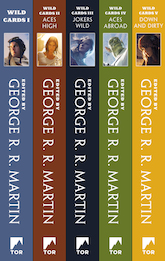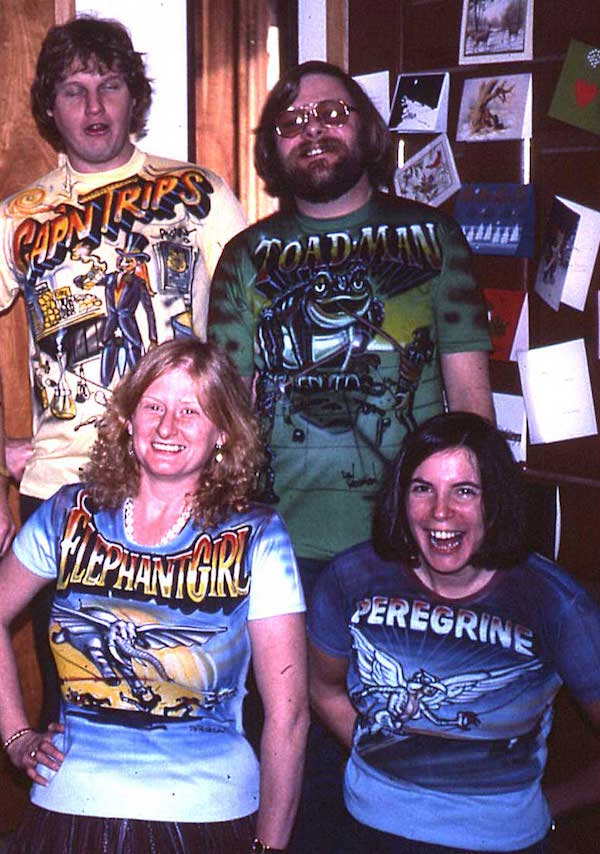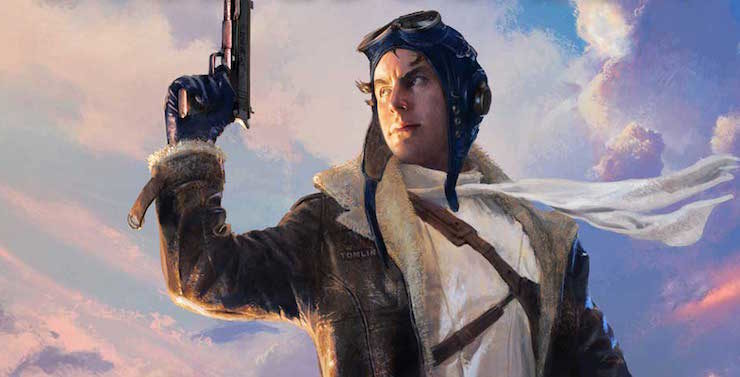At the end of last year, Hulu announced that they’ll be developing the Wild Cards series into a show (or two), sending fans into an excited furor. Over the years there’d been rumors about a show in the works, but nothing had ever come of it and many readers had given up hope. The Hulu news, then, seems like a dream come true. Never read the books? Here’s a Wild Cards primer for anyone new to the series, so you know what to expect when it hits the small screen…
So, How’d the Wild Card Virus Thing Happen?
The first thing you need to know is that the wild card virus did not arise on earth. It was created in a lab on an alien planet, Takis, and sent to earth as an experiment to see if it would genetically alter humans and affect their abilities. Only one Takisian, dubbed Tachyon by humans after the fact, came to earth to try to stop the release of the biological agent. He nearly succeeded, but the container holding the virus fell into the hands of a nefarious mastermind who decided it would be useful for getting ransom money, as one does. All this went down in 1946 in New York City, just as World War II ended, when everyone hoped the world was returning to sanity, at long last.
Little did they know. On September 15, Dr. Tod (the bad guy) took the virus in a blimp six miles above NYC, with the intent to release it. Jetboy, a young war hero with an experimental jetplane, flew up to intercept the blimp, not knowing the devastating risk he was undertaking. The blimp, the plane, and the virus ended up exploding high in the *upper atmosphere, with the biological agent carried to all the corners of the world by the wind. From that the moment on, the world irrevocably changed. (Note: For a more in-depth, spoiler-filled exploration of these events, you can check out the first installment of my Wild Cards Reread here on the site.)
Buy the Book


A Wild Cards Collection: Books I-V
Aces, Jokers, and the Black Queen
The virus released over NYC gained the name “wild card” because it impacts each person differently, with an infinite variety of outcomes. The effects are grouped into three general responses:
- Ninety percent of those affected die instantly, more often than not in a gruesome and painful manner. Death caused by the wild card virus is known as “drawing the Black Queen.”
- Nine percent will live, but will be transformed in debilitating ways, leading to physical handicaps, deformation, chronic pain, and sickness. The general population historically treated people changed along these lines as if they were side-show figures, grotesque or pitiable. These individuals are known as Jokers.
- The last one percent exposed to the virus, in contrast, experience a better outcome, gaining positive benefits, including what might be called superpowers. They are called Aces.
For the population exposed to the virus, the odds are pretty terrible, made worse by the fact that you may not experience the consequences immediately. It can happen years later. Your “card turns” randomly, during moments of high stress, or never at all, with the result that chance plays a major part in whether you draw a Black Queen, a Joker, or an Ace. Meanwhile, the remainder of the world’s population remains unaffected, and the wild carders dub them “nats” for “naturals.”
A Strong Sense of (Alt-)History
Wild Card Day in 1946 initiated what might be considered an alternative history timeline leading up to the present day. Many of the same historical trends known from the real world occur in the wild cards timeline, but are subtly (or dramatically) altered by a post-virus reality. Current events contemporary with the writing of each volume transpire within the wild cards milieu. For example, 2010’s Suicide Kings addresses the terrible reality of child armies in Africa’s Congo. Even significant places and buildings have been changed by the wild cards’ timeline, with historical effects unforeseen by the books’ authors when they first wrote them in. So, the World Trade Center towers were never built because Jetboy’s Tomb monument stands at that exact location. In the books, then, no attack on the Twin Towers ever happened, and the Towers never fell. When it comes to the larger picture, the series is nothing less than a social history of the United States (and beyond). For example, the civil rights movement – with its political ramifications and violence in the streets – includes the Jokers’ Rights effort, focused on improving the plight of jokers, who are socially ostracized and oppressed.
Genre-bending and Genre-blending
In its main components, the wild card series is something of a superhero story, but it also mixes, blends, and showcases many different genres. The various authors and plot lines draw distinct genres to the fore, as they see fit. Jetboy’s story in the first book, for example, was inspired by war comics. A science fiction element clearly marks the second book, Aces High (which features invasion by an alien swarm), and later installments involve further interactions with those virus-designing Takisians. Other volumes read like mysteries, or coming-of-age stories, or political fiction.
The entire series also has a strong urban fantasy aspect. One could argue that New York City is the real heart of the story, with its bustling cityscape, distinctive locales, and neighborhoods like Jokertown (which loosely corresponds to the Bowery in Manhattan, evolving over the decades from impoverished slum to a unique community with its own culture and customs). The city develops a tangible personality, with each installment of the series, growing book after book. Granted, some volumes do make forays into other locations, from the international jet set of Book 4, Aces Abroad, to the riverboat-on-the-Mississippi setting of Book 24, Mississippi Roll. In the end, though, we always come back to NYC.
Who’s Behind the Books?

As complex and layered as the series may be, its background and behind-the-scenes history is equally rich. The first book grew out of a long-running role-playing campaign undertaken by the authors, involving a game called Superworld. In an effort to produce some actual work from their hours of play, the authors fleshed out the story, wrote the first installment in 1987, and inadvertently created one of the longest running and most successful shared worlds in SFF literature. Eleven authors, including Roger Zelazny, Walter Jon Williams, Melinda M. Snodgrass, and Victor Milán, contributed to that first book, with George R.R. Martin editing as well as contributing a story, prologue, and several interludes. In the intervening years, nearly 50 authors have contributed to the project, with newer contributors such as Max Gladstone, Mary Anne Mohanraj, Saladin Ahmed, and Paul Cornell joining the amazing list of veterans in recent years–you can check out an updated list of Wild Cards authors here. The most recent volume, Knaves Over Queens, is the twenty-seventh book in the series, with still more to come. And though Wild Cards has crossed over into comics and role-playing games (what goes around, comes around, right?), the universe has never made its way onto the big (or small) screen before now, so there’s plenty to look forward to, now that Hulu has gone all-in on the series.
Got questions about the book series? Ask away in the comments! And you can find even more information on Wild Cards books, characters, and authors on the series’ official site.
Katie Rask is an assistant professor of archaeology and classics at Duquesne University. She’s excavated in Greece and Italy for over 15 years.










